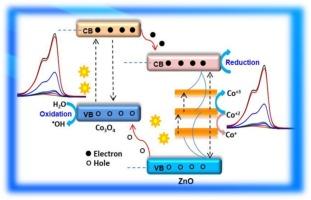Co-ZnO/Co₃O₄ heterostructures for superior dye degradation: mid-gap energy level and intent contact
IF 4.2
Q2 CHEMISTRY, MULTIDISCIPLINARY
引用次数: 0
Abstract
Improvement in materials' optical and charge transfer properties through simultaneous doping and interfacial contact has received significant attention in the catalysis field. In this study, cobalt-doped ZnO/Co₃O₄ (CZnO) heterostructures have been synthesized. The XRD pattern peak shift and appearance of the Co₃O₄ new peak on the XRD analysis confirm the cobalt ion insertion and development of an interfacial contact. The obtained average crystallite sizes for ZnO and CZnO are 26.3 and 10.7 nm, respectively. The interfacial contact between ZnO (0.273 nm) and Co₃O₄ (0.241 nm) crystals was also ratified from the HRTEM image lattice fringes analysis. The obtained particle size for CZnO is in the range of 27–50 nm, confirming the synthesized material is in the nanoscale size range. The well-scattered cobalt dispersal on the ZnO surface and anticipated elemental composition without impurities were confirmed from the EDS-mapping analysis. The attained indirect bandgap for ZnO and CZnO is 3.05 and 1.71 eV, respectively. The occurrence of a charge transfer process through the ZnO and Co₃O₄ interfacial contact was understood from the total PL intensity reduction for CZnO, compared to the ZnO. The 4.5 times greater methylene blue dye degradation enhancement for the CZnO (k = 0.141 min−1) than ZnO (k = 0.0312 min−1) is due to the improved charge transfer and optical properties. Thus, this porous CZnO heterostructure synthesized using a simple combustion approach has a novel future outlook for scale-up application.

优异染料降解的Co- zno /Co₃O₄异质结构:中隙能级和意图接触
通过同时掺杂和界面接触来改善材料的光学和电荷转移性质已经引起了催化领域的广泛关注。本研究合成了钴掺杂ZnO/Co₃O₄(CZnO)异质结构。XRD谱图峰移和Co₃O₄新峰的出现证实了钴离子的插入和界面接触的发展。ZnO和CZnO的平均晶粒尺寸分别为26.3 nm和10.7 nm。HRTEM晶格条纹分析也证实了ZnO (0.273 nm)和Co₃O₄(0.241 nm)晶体之间的界面接触。得到的CZnO粒径在27 ~ 50 nm之间,证实了所合成的材料在纳米尺度范围内。通过能谱图分析,证实了ZnO表面钴的均匀分布和预期的无杂质元素组成。ZnO和CZnO的间接带隙分别为3.05和1.71 eV。与ZnO相比,CZnO的总PL强度降低,可以理解通过ZnO和Co₃O₄界面接触发生的电荷转移过程。CZnO (k = 0.141 min−1)对亚甲基蓝染料的降解能力是ZnO (k = 0.0312 min−1)的4.5倍,这是由于电荷转移和光学性质的改善。因此,采用简单燃烧方法合成的多孔CZnO异质结构具有扩大应用的前景。
本文章由计算机程序翻译,如有差异,请以英文原文为准。
求助全文
约1分钟内获得全文
求助全文

 求助内容:
求助内容: 应助结果提醒方式:
应助结果提醒方式:


